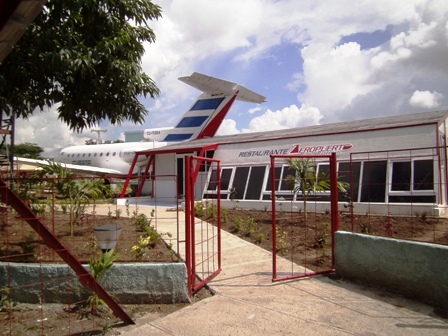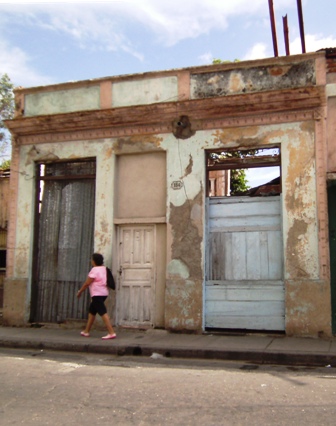Santiago de Cuba: Post Sandy Reconstruction Brings Contrasts & Questions
By Dariela Aquique (Photos: Janis Hernandez)

HAVANA TIMES — The morning of October 25, 2012, will be an unpleasant memory for the people of Santiago de Cuba for a long time to come. The horror of hurricane Sandy caused the loss of human lives (not many, thank God) and all types of material damage.
No precautions sufficed against the nefarious onslaught of the winds. Our first photo feature, completed some hours after the devastating incident, gathered truly sad images across the city.
For several days, the city was without electricity, communications and drinking water. Little by little, all services were restored. Many houses and apartments, however, weren’t so lucky.
In a second piece on the incident, written exactly six months after the tragedy, I wrote (and it is well worth remembering) that, while recovery efforts were undertaken promptly, they were by no means complete.

Today, exactly one year since the hurricane struck the province, the provincial head of Housing, Alfredo Torres, reports that 54 percent of the damage to houses remains to be repaired and only 10 percent of the cases involving the complete collapse of the dwelling have been addressed.
It is said that, in ten years, more than 29 thousand homes for those affected by the hurricane will be constructed and unsanitary conditions in different neighborhoods will be eliminated through the use of modern construction technologies.
Though local and foreign construction brigades are working in different parts of the city to erect buildings for the families who lost their homes to the hurricane and the State is covering fifty percent of the costs of the building materials sold to the victims, recovery efforts are still not enough.
The fact of the matter is that there is something of a pebble in many people’s shoes: if so much damage was done to people’s most prized possession, their homes, why were so many resources destined to other projects?
Though it is true that many facilities and establishments built or repaired through these initiatives make the city prettier, it is also true that a considerable quantity of construction materials and labor were destined to the celebrations of the 60th anniversary of the assault on the Moncada garrison this past July.

One case in point was the major repair of the Hotel Rex, undertaken for the simple reason that a number of the individuals involved in the attack on the garrison stayed there at one point.
The monumental art gallery located near the former garrison, the reconstruction and modernization of the Abel Santamaria park (where the military hospital was once located) are other examples.
Other establishments whose facades or interiors were restored or renovated have opened around the city, like the hard-currency (and perennially empty) chocolate shop.
The most questionable initiative was building a curious restaurant (shaped like an airport, and fitted with a plane), in the neighborhood of San Pedrito, one of the most severely damaged in the city.
Thus, among other things, I would like to share with you these photos, which contrast the still-damaged houses with the recently opened State establishments.
Click on the thumbnails below to view all the photos in this gallery. On your PC or laptop, you can use the directional arrows on the keyboard to move within the gallery. On cell phones use the keys on the screen.


























As flawed as the situation is (revealed by Dariela’s article and Janice’s fotos), in the case of Habana Vieja what is heartening is that, despite such redevelopment, many low- and middle-income Cubans continue to live there. Here in the States, such “redevelopment” usually means the death-knell for such dynamic neighborhoods. The working class, lower-middle class, young folks and struggling young artists are pushed out by skyrocketing rents or tax rates, to be replaced by the bland homogonization high income folks. Besides such well-known examples as the Village in N.Y.C., while attending grad school at St. John’s College in Annapolis, in the late 1980’s/early 1990’s, for example, the blacks there were pushed out of the downtown neighborhood in which they had resided since before the Civil War (as skilled freedmen who were either tradesmen or professionals, etc.) Instead, their town houses, on the narrow streets around and between the state capital and the waterfront, became new abodes for yuppies.
In Santiago, as many resources should be placed into rehabbing/rebuilding the residences damaged or destroyed by Sandy. If not, then what was the purpose of the Revolution?!
What a waste of space the chocolate place is ,what stupidity !! Hopefully someone with a more entrepreneurial hand will take it over.I can see the hand of Havana’s Eusebio Leal here, with the high end perfumeries and pharmacies in Old Havana.There ,this place would make sense,obviously it is not for Santiago.It would serve much better as a boutique department store for locals and visitors.
Thanks for that link ! I am a native New Yorker but my family is from Santiago de Cuba.I curse the name SANDY !!
Moses it’s time to stop the negative rhetoric. I can find as many if not more examples of the same in NOLA. Most still ongoing 8 years after the event.
a propos to this story and Alberto Jones’s comment, see today’s story, “Economic Divide by Superstorm Sandy Still Runs Deep” by Peter Moscowitz on today’s (26 Oct.2013) Al Jazeera America web site. Looks like the same priorities for reconstruction of businesses and upper-middle properties, as opposed to lower middle-class and working class homes, also holds true for New Jersey, Staten Island and other U.S. communities crunched by Sandy.
The horrors and devastation hurricane Sandy inflicted on Santiago de Cuba, will never be easy to explain. I spent that night under terrifying winds in Guantanamo, which was nothing compared to what I saw the next day, when I ventured into Santiago de Cuba in total ruins.
I wrote my dispassionate findings in two articles shortly after and to this day, this remains one of the worst natural disasters I have seen in my 75 years on earth.
As with all human imperfections, many of the arguments in this article should not be questioned or disputed, but I think it is unfair and opportunist to highlight minor failures in light of the monumental task that was accomplished by tens of thousands of men and women who left the comfort of their homes as far as Pinar del Rio, drove to Santiago de Cuba and worked tireless for weeks in the most difficult environment with their Santiago de Cuba brothers and sisters, to clear and restore life to a city in ruins.
Thousands of soldiers with their military trucks and heavy equipment, worked side by side with civilians clearing roads, fallen buildings and sleeping under their vehicles.
Petty critique can hurt the feelings of the average man and woman of Santiago de Cuba, the most generous people in Cuba, who in the midst of their tragedy, were sharing a bit of their water with neighbors, invented collective neighborhood kitchen, opened their bathrooms to those without and brought into their homes, those without a roof, in the most touching example of solidarity and brotherhood.
The author could have balanced her report, by inserting some pictures of hundreds of newly buitl houses and apartments buildings in San Pedrito, the historical slum of Santiago de Cuba, La Risueña and others alongside the Hotel Rex, where most of the attackers of the Moncada Garrison lodged into on July 25, 1953.
Could this article unwittingly offend hundreds of men and women who came from Venezuela, Ecuador, Nicaragua and the United States, to construct or reconstruct part of Sandy’s damage?
Would it not be fair to remind ourselves of the widespread damage that a weakened hurricane Sandy did in New York, New Jersey and other states of the union, and whose scars, devastation and despair is visible especially in Queens, Ocean City and elsewhere, where thousands of families have been unable to rebuild and hundreds are in shelters or homeless and without help.
Let me get this straight: some bureaucrat decided it was better to rebuild a hard-currency chocolate store and a restaurant with a mock-up airplane as decoration than it was to replace roofs for people to live under? Wow, try to blame that on the US embargo!